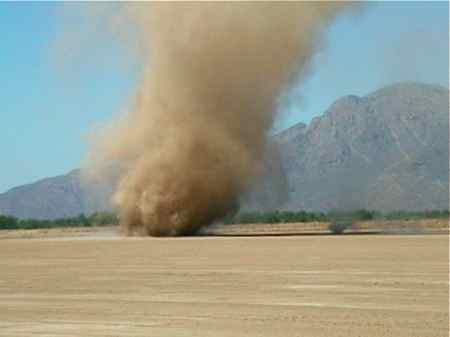
Wind isn’t acting alone in the geological process behind erosion, sand dunes and airborne dust particles called aerosols. The other culprit is electricity. By taking both factors into account, researchers at the University of Michigan have developed a new model that matches real-world measurements of “saltation” better than the decades-old classical theory.
Saltation is the process of wind blowing grains of sand across a landscape, sending them bouncing against the ground and each other. The bouncing motion of the saltating grains on the soil bed kicks dust aerosols into the air.
This new knowledge could lead to better climate models because it helps scientists understand how aerosols are released, U-M researchers say. Dust is one type of aerosol. Burning fossil fuels releases another type. They are known to affect Earth’s climate by blocking and absorbing sunlight and seeding clouds…
“The effect of aerosols is one of the most uncertain processes in climate change modeling,” Renno and Kok said. “We now know more of the physics of how dust aerosols get into the atmosphere, so we should be able to improve on the way that climate models account for their emission.”
Renno got the idea for this study while studying dust devils in Arizona and realized they had a strong electric field.















Interesting that they are looking into climate modeling of aerosols already. Of course, you put a climate spin on anything, and you’ll get funding. There hasn’t been much work in operational forecasting beyond a local effect with aerosols. The closest I can think of is work recently on the African dust layer and how it could impact Atlantic tropical systems. I’m interested in their research. I have no doubt it makes an impact. Just look at the weather records during the dust bowl.
Researching this piece [yes, we do!] – Professor Renno came to this study from his work on Martian climate and topography for NASA. The dude was already deservedly funded.
That’s why the comparison between Earth and Mars dust devils.
Interesting.
The more we learn about what is around us the more fascinating are discoveries like this. I wonder what the electrical charge means and if it is self generated by all the friction. Are tornadoes also electrically charged? Would detecting the electrical charge lead to easier detection?
Hey, I hope this research leads to something.
#3, Mr. C–
Although there is little data on this, what data there is leads to some interesting theories and subjects for future investigation.
“A tornado is electrically equivalent to several hundred isolated thunderstorm cells active simultaneously.
I’ll never forget one aircraft incident when, at 8000 ft. about 10 mi. from a tornado, lightning struck my right wing and left a 3 cm. hole just missing the wing fuel tank. We were under clear skies, no precip, visibility unlimited.
Since then, T-storm avoidance to me means 25 mi.